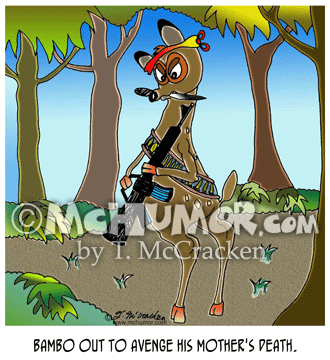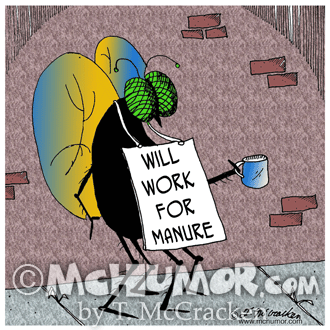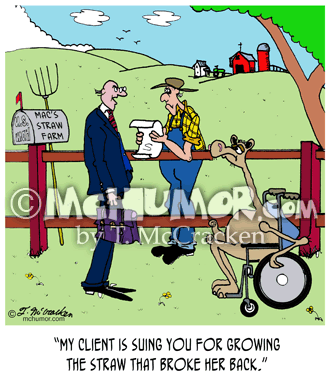Watermelon Web Works Review Parts 2: In the Beginning
On June 19, 2013, I had a long talk via Google Hangouts with Paul Clerc and Mark Leonas, two of Watermelon Web Works top web gurus. I joked that my mother told me never to hang out with strangers.
I told them about my current website. I’d designed it myself, using Adobe Dreamweaver, and I uploaded the first pages sometime in early 2000. By June of 2013 it had about 2,500 pages, and 4,200 cartoons, in the previous twelve months was visited over 600,000 times, and netted about $1,900 a month.
I wasn’t rich, but I was comfortable. I could afford an occasional round of golf, dinner out with friends, and the only beers in my house were Oregon microbrews. I’ve always told people they’ll know I’ve hit financial rock bottom if I buy a Budweiser.
Most important, I was content. Everyday I got paid to do what I enjoyed most: drawing cartoons and making people laugh. I hadn’t drawn anything on speculation in over twenty years, something few in my profession can claim.
I derive income from my website in two ways:
1) Editors and publishers find my site and commission cartoons. I charge between $35 and $500 to drawn an original cartoon.
2) I resell the cartoons on my site, charging between $7.50 and $300 per cartoon.
I had two main goals for the redesign:
1) Make it possible for customers to instantly download cartoons after they paid for them instead of waiting for me to email a jpg.
2) Make the site more suitable for viewing on mobile devices.
Mark emailed: “We believe we can make improvements to your site which will likely lead to a significant increase in revenue.” I believed they could.
They estimated the redesign would cost $3,910. People told me I could hire a reliable design company in India for half that. I’m a proud Oregonian, though, and I like the idea of supporting local businesses. Watermelon is based in Portland and Denver.
On June 24 I signed a contract with them.
On June 27 I emailed them that I realized we hadn’t discussed one of my biggest money makers: one-year subscriptions for an unlimited use of cartoons. Could they make it possible for these customers to instantly download cartoons as needed during a year?
Paul emailed, “Adding this functionality will add an additional 6 hours [$510] to the estimate.”
I said fine. Now their total estimate was $4,420. I personally set aside $6,000 for the project in case they went over budget.
On July 11 Mark emailed: “We have completed the first proofs of our proposed design for your new site! I’ve attached them to this message for your review. Please take a look and let me know what you think. From my notes I see that you are likely on your way to Norway now, but hopefully you’ll have access to email so that we can move forward with the design. If we don’t hear back from you sooner, we’ll be sure to check in again in three weeks when you return. Either way, have a fantastic trip.”
I replied: “I’m at PDX, but had a chance to look over the proof and it looks great.”
I was on my way to visit my brother and his family in Norway, one of the most expensive countries in the world. I had money in the bank so felt flush, and soon expected to be flusher.
Next: Web Design 101

License Computer Cartoon 5507
Get it printed on stuff from Cafepress
More Computer Cartoons for use in ads, self-published books, etc.So cheap you can afford them even if you’ve paid your web designer way too much.
Watermelon Web Works Review Part 3:
Web Design 101
On October 31, 2013, Watermelon Web Works emailed: “Your new website is all setup and ready to be reviewed.”
“Yikes,” I thought when I went to the site. “The cartoon images are blurry.” This might be OK for a site trying to sell impressionist paintings, but not for one trying to sell print-ready images. The problem was easily fixed, but it troubled me that no one noticed this in the first place.
Something not as easily fixed was the list of cartoon categories. It was filled with really peculiar ones. My personal favorite: “business insurance weather alaska winter water house family.” That’s not eight separate categories, but one. Talk about niche marketing!
Watermelon had created the list by using a database of mine that had never been intended for anything but my personal use, thus the peculiar categories. What was troubling was that Watermelon either did not notice the peculiar categories and typos, or they thought they didn’t matter.
They mattered to me, so I told them I would manually go through all 4,200 cartoons on the site and assign them to proper categories. It took me three months because not only was it a monumental task, but I also still had dozens of commissions to draw.
On November 4 Watermelon sent me an invoice for $2,897.08. It was for work I had already paid for in October. I emailed their billing guru and she quickly replied: “I applied the payment to your account. Sorry for any confusion this caused!”
It didn’t cause confusion. It nearly caused a heart attack.
On February 4 I emailed Watermelon: “I’ve finished with cleaning up the categories and wrote my first blog, so are we set to launch?”
On February 7 I replaced some gif images on the site where a watermark covering something made it difficult to understand the cartoon.
Before:
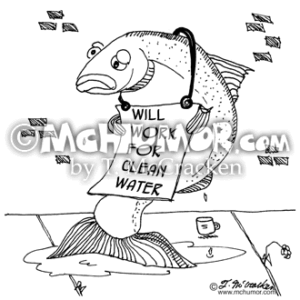
After:
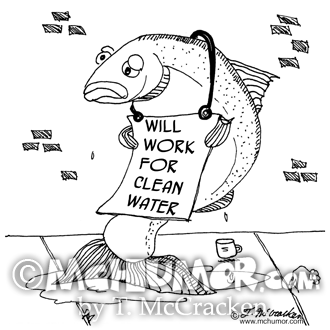
After
Buy Environment Cartoon 7030
Get it Printed on Stuff From CafePress and Zazzle
Watermelon had put a copyright watermark in the center of all 4,200 cartoons. We hoped that a watermark would deter people from illegally using them without paying for them. On about a third of the cartoons the watermark was not well placed. This was not Watermelon’s fault because they probably used something called a “macro”, an efficient way to do repetitive tasks on a computer. It took them four hours at $85 an hour.
It would have taken monk scribes decades to do such a task, and the problem with monk scribes is you have to keep plying them with wine. But I digress.
It would have taken me about twelve hours to do such a task. I know, because I ended up doing such a task. I created my own Photoshop macro, but before clicking “Save” I looked at the cartoon with my human eyes. If I didn’t like the watermark’s placement, I moved it.
Swapping those gifs on the cartoons’ product pages (the pages that let people buy cartoons) would take me much longer. There was probably a way Watermelon could have automated the job so it would only take a few hours, but I didn’t discuss it with them. The project was already over budget and the site wasn’t finished.
By that point I had paid them about $6,100, almost $1,700 more than their original estimate and $100 more than I personally had budgeted for the redesign.
They charge $85 an hour so I went to work manually swapping the images myself. I started with my best-selling cartoons.
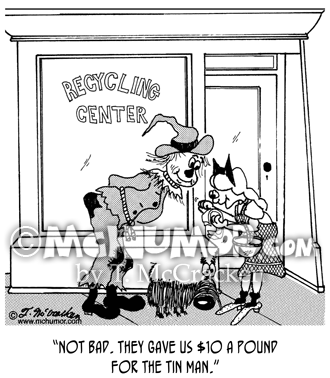
Buy Recycling Cartoon 4801
Get it Printed on Stuff at CafePress
After I changed the image on one of my personal favorites, Recycling Cartoon 4801, I tested the shopping cart and bought that cartoon. The price I charge depends on who a customer is and/or the planned use for the cartoon. For instance, I charge self-publishing authors $20, advertisers $50, magazines $150.
When I bought the cartoon myself, I clicked the teacher option. I should have been charged $7.50. I was charged $50. No matter what use I selected on this cartoon I was always charged $50.
I immediately emailed Watermelon.
The new site was to go live in ten days.
Next: IT’S ALIVE!
Computer Cartoons for use in blogs, ads, etc.So cheap you can afford them even if you’ve paid your web designer way too much.
Watermelon Web Works Review Part 4: IT’S ALIVE!
On February 16, 2014, my website was visited 939 times and I sold no cartoons. It was a Sunday and Sundays are always slow. Too many people wasting time reading the Sunday comics.
On the day before, though, I sold four cartoons for a total of $60; the day before that I sold a cartoon for $85 and was commissioned to draw a cartoon for $300; the day before that I sold $180 worth of cartoons; and—well, I could go on, but you get the idea. I was having a good month, and I figured it was only going to get better because my “new and improved” site was about to be launched.
On February 17 Watermelon Web Works, my web designers emailed: “The new site has just been made live. The ‘propagation’ (time that it takes to have switched over across the planet) is usually a few hours.”
I celebrated with friends at Yuzen, a restaurant owned by another friend. I’m nervous,” I said. “If this bird doesn’t fly, I might have to get a real job and I really don’t think I’m Walmart greeter material.” The owner joked, “You can always come here and wash dishes.”
That day the site was visited 706 times.
On February 18 the site was visited 61 times and I sold one cartoon for $7.50.
I emailed the customer: “I relaunched my site today and you have the dubious distinction of being my first sale since then. THANKS. Did you get the cartoon?”
“No,” she replied. “I just clicked on the link that was in the e-mail receipt and got the same message: The file could not be opened. Thanks!”
Sigh. One of the main reasons I’d had the website redesigned was so customers could instantly download cartoons after they paid for them instead of waiting for me to email a jpg.
Oh well. A few glitches in the first few days were to be expected. I emailed her the cartoon and emailed Watermelon about her difficulties.
On February 19 the site was visited 20 times, and I sold 2 cartoons for a total of $20.
On February 20 the site was visited 13 times.
On February 21 the site was visited 5 times.
On February 22 the site was visited 27 times.
I breathed a sigh of relief. The site was on the upswing.
On February 23 the site was visited 5 times.
On February 24 the site was visited 5 times, and I sold 2 cartoons for a total of $17.50.
On February 25 the site was visited 4 times.
On February 26 the site was visited 5 times.
On February 27 the site was visited 5 times.
On February 28 the site was visited 3 times.
The 27 visits the site had on the 22nd proved to be an anomaly: probably my mom and dad checking it out.
Three: That was the average number of daily visitors my new site would have for the next six months.
In its first eleven days the site grossed $27.50. I pay about $137 month in various fees to keep the site up and running (about $4.51 a day), so the site had lost $22.11.
During the same period a year earlier, February 17 to February 28, 2013, the site was visited over 17,500 times and I netted (not grossed) $700.
More Information Than You Probably Want About Fees
On my old site I had two monthly expenses: $41.95 to Pioneer Telephone, my Internet provider, and $19.95 to Watermelon to host my site.
On my old site the only way I could accept credit cards was via Paypal. Paypal has no monthly fees. They charge per transaction 2.9% plus 25¢.
On the new site Watermelon set it up so I could accept credit cards via Authorize Net. I haven’t quite figured out their fee structure because they don’t charge me the same amount every month. It averages around $25 a month. They also take 4% of all sales.
I also pay fees to On Line Data. Truthfully, I’m not sure what their role is in the whole scheme of things. I think they have something to do with Authorize Net, but I’m not sure. I called their technical support for information, and when I hung up I was as bewildered as ever. What I do know is that I pay them about $45 per month.
In other words, my site isn’t in the black for the month until I’ve made a total of $137 in sales.
Next: My Dog Dies
Computer Cartoons for use in presentations, web sites, etc.So cheap you can afford them even if you’ve paid your web designer way too much.
Watermelon Web Works Review Part 5: My Dog Dies

Sammy and T-
On March 4, 2014, I emailed Watermelon Web Works: “Everyone says that they love the new site. The only hiccup seems to be the home page when viewed on a smartphone.”
One of the main reasons I had hired Watermelon to redesign my site was so it would be easy to use on smartphones. Sigh.
On March 4 I also sold 2 cartoons for a total of $50.
On March 9 I sold 1 cartoon for $20.
On March 10 I sold 5 cartoons for a total of $100.
On March 12 I sold 1 cartoon for $10.
On March 13 I sold 1 cartoon for $15.
On March 17 I sold 2 cartoons for a total of $37.50
On March 19 I sold 2 cartoons for a total of $17.50.
On March 22 I sold 1 cartoon for $7.50 and sold 1 license for a year of unlimited use of Mchumor.com cartoons for $100.
On March 24 I sold 1 cartoon for $10.
On March 25 I sold 1 cartoon for $25.
On March 27 a potential customer emailed: “How do you purchase use of a cartoon? I have registered but can’t get the cartoon to be in the shopping cart?”
The button that allowed people to buy cartoons had vanished!
I emailed Watermelon.
They replied: “We have successfully restored the file system from earlier in the week. There was an update made in the e-commerce software that caused a few issues. That has been remedied. Thank you.”
No, “Sorry. Hope you didn’t lose too much business”? Double sigh.
On March 29 Sammy, my beloved dog, died of complications from a second surgery for cancer. Uncontrollable sobbing.
Let me be clear: Watermelon was not involved in the surgery.
On March 30 I sold 1 cartoon for $15.
That customer emailed: “Unfortunately, we are unable to open the image. Would you please check that this is not a corrupted file?”
This was the second time someone had been unable to download a cartoon since the new site went live, and so far I’d only sold 18 cartoons. One of the other reasons I’d had the website redesigned was so customers could instantly download cartoons after they paid for them instead of waiting for me to email a jpg. Triple sigh.
I emailed the man the cartoon and then bought it myself to see what happened. I too couldn’t download it. Hoping it was a problem with just this one cartoon, I order a different one. Same result.
I emailed Watermelon. The next day they replied: “This problem has been corrected.”
I was later billed $28.33 for .333 hours to “Analyze and test website user experiences. Created test transaction to replicate problematic order for a customer.” That $28.33 was $13.33 more than the actual transaction. Quadruple sigh.
In March the site was visited under 100 times and grossed $402.50. I pay about $137 a month in fees to keep the site up and running, so the site netted $265.50.
Commissions are where much of my income comes from. I not only had no new cartoons commissioned since the new site went live, no one had even inquired about a commission.
I hadn’t had such a dry spell since the early 1980s when I first started cartooning professionally.
During the same period a year earlier, March 2013, my site was visited over 42,700 times, and netted (not grossed) $2,000.
The numbers were dismal, but at least this month the site was in the black.
It wasn’t in the black for another five months.
Next: Duplicate Content
Computer Cartoons for use in ads, self-published books, etc.So cheap you can afford them even if you’ve paid your web designer way too much.
Watermelon Web Works Review Part 6: Duplicate Content
There were many days in April 2014 when my website had no visitors. I had no shortage of bills, though, especially from my web designers, Watermelon Web Works.
On April 5 Watermelon sent an invoice for $467.50 for work I had paid for in February. This was the second time I was double-billed.
I emailed their billing guru and she promptly replied: “I just updated your account to reflect the payment you made. Sorry for any confusion this may have caused.”
The previous time I was double billed the billing guru replied: “I applied the payment to your account. Sorry for any confusion this caused!”
On April 9 my parents gave me an early birthday present: a seven-week-old puppy. He was my first puppy. I’d had dogs before, but they were all adults when I rescued them.

Me and Sammy April 10, 2014
On April 15 I sold one cartoon for $25.
On April 17 I sold one cartoon for $15.
Google hated the redesigned site and was penalizing me. In January pages on my old site came up among the top three results if you Googled “Science Cartoons” or “Law Cartoons.” Now I was lucky if they appeared anywhere in the first three pages of results.
Watermelon hired two external consultants to “audit” the site to figure out why this was so.
They said I had too many cartoon categories. Like my old site, the new site had about 400 categories. They said I should delete and/or merge at least 300 categories, if not more.
The site had a lot fewer categories than there were in October 2013 when Watermelon first emailed me: “Your new website is all setup and ready to be reviewed.”
Watermelon had created the initial categories list by using a database of mine that had never been intended for anything but my personal use, so it had some really peculiar ones. My personal favorite: “business insurance weather alaska winter water house family.” That’s not eight separate categories, but one. Talk about niche marketing!
Niche marketing has been key to my success, though. “Humor targeted to any audience, be it anal-retentive astronauts,
or zoologists in zero gravity.” That’s the header on my web pages.
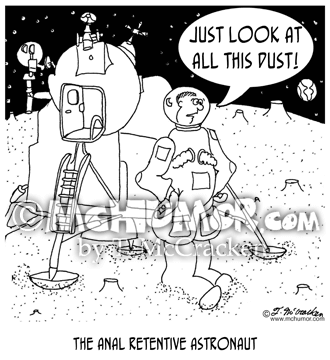
Buy Cleaning Cartoon 6530
Get it Printed on Stuff at CafePress
or zoologists in zero gravity.”

Buy Gravity Cartoon 7165
Get it Printed on Stuff at CafePress
Like most cartoonists I’m often asked: “Do you draw for the New Yorker?” “Yes,” I say, “but they’ve yet to have the good sense to buy one of my cartoons.” Maybe that’s because I haven’t sent them anything in decades. I figure I have a better chance of being abducted by space aliens than having Bob Mankoff give me a call, so why waste postage?
At least Watermelon didn’t say get down to one category: cartoons. Googling “Cartoons” yields about 230,000,000 results, and The New Yorker usually comes up among the top three results.
Googling for cartoons on something more specific, say science, and you only get about 55,300 results. Search for cartoons in a scientific field, say biology, and you get about 7,540 results. Narrowing it further to cartoons in a biology specialty, say genetics, and there are a mere 2,020 results.

Buy Biology Cartoon 1031
Get it Printed on Stuff at CafePress
The above cartoon is one of my best-selling science-related cartoons, and I’ve sold it more times from my Genetics Cartoons Pages than from my Biology Cartoons Pages and Science Cartoons Pages combined.
Now Watermelon was proposing I merge genetics, biology, and all my other science-related cartoon categories (e.g. physics, chemistry, water quality) into one category: Science.
Same thing with law-related cartoons. Googling “Police Cartoons” yields 12,500 results. Narrowing it to a type of police officer, say a highway patrolman, and you get 369 results.
The cartoon below is one of my best-selling law-related and science-related cartoons, and I’ve sold it more times from my Highway Patrol Cartoons Pages and my Gravity Cartoons Pages than from my Police Cartoons Pages and Physics Cartoons Pages combined.

Buy Physics Cartoon 5077
Get it Printed on Stuff at CafePress
Now Watermelon was proposing I merge police, highway patrol, and all my other law-related categories (e.g., court reporters, security guards, and lawyers) into one category: Law.
Another thing the auditors concluded was hurting the site was what Google interpreted as “duplicate content.” Google hates duplicate content. Hates, hates, hates.
Duplicate content is where the same image and text appear on multiple pages.
I’d never heard the term “duplicate content” before. I now hate the term duplicate content. Hate, hate, hate.
On the new site the cartoon about the driver violating the laws of gravity was assigned to the same six cartoon categories it was assigned to on my old site: Gravity, Physics, Science, Highway Patrol, Police, and Driving.
Watermelon said it would be best if I could now assign it to just one category.
If your eyes are glazing over about now, think how my eyes were glazing over when I was reassigning categories to 4,200 cartoons for the new Watermelon site. It took me three months because not only was it a monumental task, but at that time I had dozens of commissions to draw. While working on the categories, I regularly updated Watermelon on my progress.
Did during all that time nobody at Watermelon realize that Google might have a problem with the number of categories or duplicate content? They tout on their own website that they have “been in business since Google was an upstart.”
I ended up spending almost another month merging and getting rid of hundreds of categories. I had the time since there were no visitors to the site so I didn’t have any new cartoons commissioned.
Another of the consultants’ conclusions was that Google was penalizing me because the site had “thin content.”
I had 4,200 cartoons on the site. What did they mean it had “thin content”?
Next: The Reluctant Blogger
Computer Cartoons for use in books, presentations So cheap you can afford them even if you’ve paid your web designer way too much.
Watermelon Web Works Review Part 7: The Reluctant Blogger
In April 2014 Watermelon Web Works hired two external consultants to figure out why Google hated the site they had redesigned for me.
One of the consultants’ conclusions was that Google penalized the site because it had “thin content.”
The site had 4,200 cartoons on it. What did they mean it had “thin content”?
Google, according to Watermelon, likes blog posts. Lots and lots of them.
Blogs, according to Paul Clerc, Watermelon’s top web guru, were “like candy to Google.”
And cartoons? They were like boiled Brussels sprouts to Google?
On my old site I never needed to blog to get visitors, an average of 1,200 a day. The new site had 3 on a good day.
I did have a blog on my old site, but it only had sixteen posts, and I hadn’t posted anything since 2010.
No matter, Paul said, blogging was key to saving my site.
One of the other web gurus at Watermelon once wrote me, “Blogs are considered highly sharable, so write great blog posts for people to share!”
Write great blog posts for people to share? Did Watermelon think writing was a snap, that I could whip something out while waiting for my morning coffee to brew?
English was always my biggest challenge in school. It takes me hours to write a coherent paragraph, and I have no idea whether I can ever write one worth sharing.
That’s why I’d stopped blogging in 2010. Blogging kept me from what I am good at: cartooning. A picture is not only worth a 1,000 words, a picture doesn’t have dangling participles … whatever the heck dangling participles are.
Still, if blogging was what I needed to do to save the business it took me 33 years to build, I would blog. It wasn’t as though I was busy drawing cartoons. Since the redesigned site went live I hadn’t had any new cartoons commissioned.
As Watermelon says, blogs are considered highly sharable, so feel free to share–especially with anyone you know who’s looking for a web designer.
Next: My Site is Lost in Cyberspace
Computer Cartoons for use in newsletters, ads, etc. So cheap you can afford them even if you’ve paid your web designer way too much.
Watermelon Web Works Review Part 8: My Site is Lost in Cyberspace
When I was in high school in the early 1970s we learned how to use a slide ruler and, no joke, went on a field trip to see a computer.
About thirty years later, sometime in early 2000, I uploaded my first web pages to www.pioneer.net/~mchumor. The name just rolls of the tongue, doesn’t it? It was free web space my Internet-provider, pioneer.net, provided.
I eventually bought the domain name, mchumor.com.
I don’t remember the exact date the site went live because I didn’t view it as a momentous event. Selling my first cartoon on November 6, 1981, now that was a momentous event.
The cartoons I uploaded to my awkwardly named site weren’t the first ones of mine to appear on the web. In 1991 someone from Quantum Computer Services called to say they wanted to publish my cartoons on something they thought was going to really catch on soon with the general public, something called the Internet.
On May 14, 1991 I received the first of many royalty checks from Quantum. The checks continued even after they changed their name to America Online. I was one of the first cartoonists to have work appear regularly on the web.
Another reason I didn’t view my site going live in 2000 as a momentous event was because for a long time it didn’t change the way I did business. I continued selling cartoons the way I had for the previous twenty years: snail-mailing (although then it was simply called mailing) batches of cartoons to editors with an enclosed self-addressed stamped envelope. In queries to editors I told them they could see more of my work on my site.
At some point–I can’t remember exactly what point–I had enough editors coming to the site querying me and asking me to draw cartoons for them, that I stopped sending out queries.
Over the years many other sites put links to my site on their sites, something called backlinking. Some sites pay to get backlinks. I never did. I never even asked people to put backlinks on their sites. They just did it because they liked my cartoons.
My site was considered such a high-quality site that I frequently was offered up to $150 to put one backlink for a year on one of the 2,500 pages on it, more if I’d put the link on my homepage. Today Google penalizes sites that pay for backlinks because backlinks are one of the, if not the, best things you can have to get high marks from Google.
It appears that I may have lost the value of these backlinks when Watermelon Web Works redesigned my website and it went live in February 2014.
Google hated the new site. My old site averaged 1,200 visitors a day. The new site averaged 3.
In April 2014 Watermelon hired two outside consultants to figure out why this was so.
On April 15, Paul Clerc, Watermelon’s top web guru, sent me a lengthy email about the consultant’s findings and things Watermelon was doing to bring the numbers back up.
He said, among other things: “We implemented a large number of redirects based on a naming convention. For example, science_cartoons.html on the old site would be converted to science-cartoons on the new site. … It will help improve the “backlink equity” for the site so that Google regards the site as a higher quality site and will give “credit” for every backlink.”
I can tell some of you have eyes beginning to glaze over, but try and stay with me, as this is not a trivial matter.
Google prefers website addresses with dashes ( – ) to ones with underscores ( _ ). All the web pages Watermelon designed used dashes. All the 2,500 plus pages on my old site used underscores.
I can’t remember why I used underscores in my site’s addresses when I started it. Maybe it was the norm. It certainly wasn’t an issue. At the time Google was less than two years old and not yet the all-powerful cyber-God everyone was trying to appease.
Can you imagine the penalty Google would give a site today with a tilde in its address?
I’m assuming when Paul says they “implemented a large number of redirects” they used what’s called a 301 Redirect. A 301 Redirect is akin to giving the post office a snail-mail forwarding address when you move.
With no 301 Redirects people who clicked on links to the old version of my site (whether they clicked on a backlink, or they copied and pasted a link they’d used before, or they used a link in their browser cache) they were sent to my 404 Redirect page, a page that said, “Can’t find that page, sorry… ”
Paul once told me that people usually left a site if they couldn’t find what they wanted in two or three clicks, so, as I said earlier, this was not a trivial matter.
Had I realized Watermelon wasn’t going to do 301 Redirects from the start, I would have” implemented” the redirects myself, a project that manually would have taken me less than a week to do using a WordPress plugin appropriately called, 301 Redirects.
I emailed Paul: “I hesitate to ask, how much did the consultants cost?”
He replied: “If this doesn’t work, we are not planning on charging you for the consultant fees at all, so we can talk about that once you are in the black again.”
Good news/bad news: I was never charged for the consultants’ fees because I was never in the black again.
Next: A Wrecking Ball Hits My Site
Computer Cartoons for use in presentations, websites, etc. So cheap you can afford them even if you’ve paid your web designer way too much.
For The Techies And/Or Insominacs Out There:
Paul’s complete email about the outside consultants’ “audit” of my site and Watermelon’s redirects.
From: Watermelon Web Works – Projects
Subject: [#OOK-850-35076]: McHumor.com – import process, etc.
Date: April 15, 2014 9:59:38 AM PDT
To: Theresa McCracken
Cc: Chance Corbeil
Reply-To: Watermelon Web Works – Projects
Good morning Theresa.
An update on the Google penalty. As I mentioned in the below exchange, we
hired an external consultant (two separate ones, actually) to assess the problems
with McHumor.com.
What they found is not conclusive, because Google’s algorithms for ranking
websites for given key phrases is proprietary. However, our experience combined
with the opinions of the external consultants has led us to believe that the
following are the problems that have contributed to this penalty:
1. Overlap of tags and categories. There are several tags and categories that are
either overlapping or identical. To put it generally, Google interprets this as
“duplicate content”. To remedy this issue, we have added a “noindex” tag to
these pages. This means that Google will acknowledge the tag pages and they
will be searchable on the site, but that they will deprioritize them for indexing, and
most likely the pages with tags will be delisted.
2. Ratio of pages with “thin content” to other pages in the site. This was pointed
out by one of the consultants. His observation was that the product pages (such
as https://thekomic.com/cartoon/7458-pirate-cartoon/) have only a sentence or
two of unique content each. These pages comprise a disproportionate number of
the total pages on the site, and he thinks that Google’s “Panda” algorithm is
interpreting the site as “low quality” because of this. We have also “noindex’ed”
these pages.
3. Naming changes. We implemented a large number of redirects based on a
naming convention. For example, science_cartoons.html on the old site would be
converted to science-cartoons on the new site. In the past couple of days, we
have gone into more depth and fixed more obscure links so that links outside of
this naming convention are also redirected to their new equivalents. This will not
directly affect search engine listings, but it will help improve the “backlink equity”
for the site so that Google regards the site as a higher quality site and will give
“credit” for every backlink.
So. These changes have all been implemented over the last few days. Google
needs to reindex the site and re-apply the algorithms to it. We have been
extremely thorough, and we are hopeful that these changes will cause Google to
remove the penalty that we believe is being applied to the site. Of course the
vexing thing about all of this is that it is impossible to know whether a penalty is
truly being applied or that our changes will get it removed, but we have good
reasons for confidence on both of these items. Paul McNamara (the consultant
who recommended the product page changes) tells me to expect the algorithm to
take 4 weeks to reassess and reinterpret the site.
We recognize that this is a very frustrating process for you. I assure you that we
are doing everything possible to understand what is happening with your site and
to address the problems in the most complete and efficient way possible. If you
have any questions, we are at your service.
Thank you,
Paul
Watermelon Web Works Review Part 9: A Wrecking Ball Hits My Site
My website, redesigned by Watermelon Web Works, was visited seven times during the week of April 15-21, 2014. Six of those visits were from me.
Watermelon had hired two external consultants to “audit” the site to figure out why Google hated the new site. Changes were “implemented” on April 15. Paul Clerc, Watermelon’s top web guru, said it would probably take four weeks for Google to “reindex the site and re-apply the algorithms to it.”
One week down, three very long weeks to go.
I wrote Paul Clerc: “I’m sure it will all work out, but it is nerve-wracking.”
He replied: “Yes, it sure is nerve-wracking. Google has wrecked a lot of businesses with their algorithm changes, which are entirely proprietary. We have managed to avoid the wrecking ball until this project, so unfortunately it is not our specialty, but we do have a good understanding of the issues (and hired outside support to confirm our hunches).”
Just my luck.
On April 17 at 11:11 am I sent out an email via Mail Chimp titled Mchumor Cartoons of the Week. The addressees consisted of people who had purchased cartoons in the past or expressed an interest in my site. Four minutes later, at 11:15 am, Mark Leonas unsubscribed. He was another of Watermelon’s top web gurus and in June 2013 had emailed me: “We believe we can make improvements to your site which will likely lead to a significant increase in revenue.”
At least he took the time to click why he was unsubscribing: “No longer interested.”
His unsubscribe was the fastest response I ever had from someone at Watermelon.
On April 23 I sold one cartoon for $15.
On April 24 I sold one cartoon for $10.
On April 29 I sold one cartoon for $15.
On April 30 I sold one cartoon for $15.
In April the site was visited under 100 times and grossed $70, I had no new cartoons commissioned, nor queries about commissions. Since I pay about $137 a month in fees to keep the site up and running, the site lost $67.
During the same period a year earlier, April 2013, my site was visited over 54,000 times, and I net (not grossed) $1,850.
On May 4 I wrote Paul:
OK, now I’m seriously panicking. Before the relaunch I was number one or two in a Google search of “Construction Cartoons.”
Three weeks ago, right after the audit, I was on the second page.
Today I am on the seventh page. Ironically, my Cafepress Construction Cartoon Shop was on the third page.”
On May 5 I sold one cartoon for $25.
On May 6 I sold one cartoon for $25.
On May 7 I sent out my first tweet, “The advantage of getting a puppy at 57 is your bladder holds about as much as a puppy’s, so house breaking is easier.”
I also wrote a blog post, My Life Has Gone to the Puppies
On May 8 one of the Watermelon support team wrote: “We are sorry to hear that you are unhappy with the status of your website. We certainly understand the difficulty and have been working hard to help analyze the website status within Google. Five additional hours has been donated to your site to help improve and analyze various contents.”
“Unhappy with the status of my website”? I don’t know why, but that line immediately reminded me of one I’d head about a of a hospital patient “not achieving his wellness potential.” That sounded so much better than “he died.”
Next: My Customers Are Overcharged
Computer Cartoons for use in newsletters, blogs, etc. So cheap you can afford them even if you’ve paid your web designer way too much.
Watermelon Web Works Review Part 10: My Customers Are Overcharged
On May 13, 2014, I sold one cartoon for $50.
I examined my merchant’s receipt and realized the customer had been overcharged.
I immediately emailed her: “I only charge $15 for use in presentations. I’ll figure out how to rebate you the $35. I just relaunched the site, and there have been glitches.”
She graciously replied: “Thanks very much, I feel it is worth 50 bucks. I have been looking for this exact humor for 3 hours so please, keep the 50 and THANK YOU!”
I replied: “Wow! The money is appreciated in that my relaunched website has been beset by problems and you’re my first sale in over a week. If you find two other cartoons you want, let me know and you can have them too.”
I went to Medical Cartoon 7018’s product page and bought the cartoon myself.

Buy Medical Cartoon 7018
Get it Printed on Stuff from CafePress
No matter what use I selected, I was charged $50.
The price I charge depends on who a customer is and/or the planned use for the cartoon. For instance, I charge non-profits $10, $35 for use on a flier, and $100 for use in a textbook.
This was the exact same error I wrote Watermelon about on February 7.
I randomly tested other cartoons. Some charged me the correct price. Some didn’t. I emailed Watermelon about the problem.
On May 19 I sold one cartoon for $25.
On May 22 Watermelon sent an email that started with, “After much troubleshooting, we deciphered what happened here, which is that there were many … “ and then there was a lot computer speak. The entire email is at the end of this post.
It ended with:
So in short, please do not delete any attributes. They are not meant to be manipulated at all in bulk. Any time you see something that says “Bulk Actions”, Beware!
So now we need to find the programmatic equivalent to going through and clicking “remove” 4200 times.
“I mustn’t delete attributes in bulk.” I thought. “I’ll have to remember that … if I ever figure out how to do anything with attributes.”
At the time I only had a vague notion of what an attribute was and how it worked and had no idea how to edit or delete one, much less how to delete them in bulk.
I told Watermelon that I had not edited any attributes on the cartoon product pages.
On October 29 I figured out a programming error caused the price glitches, something I write about in Part 16 of this review, but that’s jumping ahead.
Most of the editing I had done on product pages was changing cartoon images.
All of my cartoons have watermarks on them. It’s an attempt to deter people from using them without paying for them. It so easy to download images from the Internet, people don’t realize many are copyrighted. If you look at the footer of this page you’ll see I say: “If you wouldn’t steal a newspaper from a blind vendor just because you could get away with it, please don’t use a cartoon without permission just because you think you can get away with it. If you would steal a newspaper from a blind vendor, well, I hope you die laughing before you have a chance to steal my work.”
Considering the number of images of mine that have been stolen, there must be a lot of blind vendors out there routinely ripped off.
Sometimes the watermarks on my cartoons obscured something vital to understanding the joke. I was now editing their product pages and swapping those images with better ones. I had the time since I hadn’t had a single cartoon commissioned since February.
In May the site was visited under 100 times, grossed $125. Since I pay about $137 a month in fees to keep the site up and running, the site lost $12.
A year earlier, May 2013, the site was visited over 53,000 times, and I net (not grossed) $1,900.
Next: The Blame Game
Computer Cartoons for use in presentations, blogs, etc. So cheap you can afford them even if you’ve paid your web designer way too much.
Watermelon Web Works Review Part 11: The Blame Game
On June 8, 2014, I sold two cartoons from my site for a total of $40. The transaction went smoothly: the customer was charged the correct amount and was able to instantly download the cartoons as soon as he paid for them. The cyber Gods were with me that day.
On June 11 I sold one cartoon for $15, and the customer was able to instantly download the cartoon. At least that part of the transaction went as it was supposed to.
I looked at my merchant’s receipt: The customer had checked that he was going to use the cartoon in multiple presentations. I charge $15 to use a cartoon in one presentation, $30 to use it in multiple presentations.
Perhaps the cyber Gods were distracted mid-transaction by a new cat video being uploaded.
Even though the site had netted less than $170 since February, I ate the loss. I didn’t inform the customer of the error because he had done nothing wrong.
I did inform Watermelon Web Works, the company that had redesigned my website. This had been an ongoing problem. One day customers would be charged the proper amount, the next day they wouldn’t.
I could live with a customer being undercharged. Having her overcharged was another matter. Whenever I catch a mistake made in my favor, I rectify it. I may be poor, but I’m honest. Besides, a sure way to get a bad Yelp review is to charge someone $50 when she only owes $15.
On June 12 Paul Clerc, Watermelon’s top web guru, wrote an eye-glazing email about this glitch. That email and other emails about this glitch are at the end of this post.
The line from it that stung was: “We have fixed all of these missing attributes at this stage, but it is a very time-consuming process, so please help us to help you by not changing those.”
When this glitch had happened before, Watermelon claimed I had caused the problem by editing something called attributes on cartoon product pages. I told them I hadn’t edited attributes, that I barely understood attributes.
Now they again said I had caused the problem by editing attributes on cartoon product pages, and I again told them I hadn’t edited attributes, that I barely understood attributes.
OMG, I was living in my own version of the movie, Groundhog Day.
On October 29 I figured out that a programming error caused the price glitches, something I write about in Part 16 of this review, but that’s jumping ahead in the story.
On June 14 I sold 2 cartoons for $7.50 each.
On June 20 I sold 1 cartoon for $12.50
On June 24 I sold 2 cartoons for $7.50 each
One customer was unable to download the cartoon, so I emailed it to him.
This was the third time someone had been unable to download a cartoon since the new site went live, and I’d only sold 35 cartoons. One of the main reasons I’d had the website redesigned was so that customers could instantly download cartoons after they paid for them instead of waiting for me to email them a jpg.
On June 25 I sold one cartoon for $35.
In June the site was visited under 100 times, grossed $132.50, and I had no new cartoons commissioned nor queries about commissions. Since I pay about $137 a month in fees to keep the site up and running, the site lost $4.50.
During the same period a year earlier, June 2013, the site was visited over 41,000 times and I netted (not grossed) $1,900.
By this time I had paid Watermelon a little over $7,800–77% more than their initial estimate of $4,420. Since the site went live in February it had netted $159.89. The only month that showed a profit was March, and that’s probably because there were still vestiges of my old site somewhere in cyberspace.
On June 29 I emailed Paul:
To pay the bills, I’ve been leading nature hikes all week and apparently my site has also been absent. According to Google Analytics I had ZERO visitors on Saturday, Monday, Wednesday and Friday and a whopping ONE on Sunday, Tuesday and Thursday (i.e. THREE visitors all week). Any chance of getting a refund?
Mirthfully yours,
T- McCracken
humble cartoonist
Next: In Google’s Crosshairs
Computer Cartoons for use in text books, advertisements, etc. So cheap you can afford them even if you’ve paid your web designer way too much.
***
Uncut emails between Watermelon and me about the price glitches. They are unedited. I even left in my own typos.
From: Theresa McCracken
Subject: Re: [#MKX-955-62667]: McHumor Cart Problems
Date: June 11, 2014 11:13:32 PM PDT
To: Watermelon Web Works – Projects
Cc: Chance Corbeil, Paul Clerc
The good news: almost 25% of the people who visited my site this July [sic] have made a purchase.
The bad news: of the 34 sessions this month, 25 were from me, visits I made while working on reducing the duplicate content of the site. I’m hoping to have that all done in a week. Most of the cartoons now only have one category assigned to them.
The good news: Today I made my second sale this month.
The sale was for cartoon
The buyer selected the multiple presentation option which should cost $30.
Good news for him/bad news for me: no matter what variation he picked, whether it was the $7.50 teacher option or the $75 magazine option, he would only charged $15.
I then randomly selected another cartoon,

This time all the options charged $50
I randomly selected another cartoon

This time the prices in the shopping cart came out correctly, but it only had four options: Ad on a postcard, $50, magazine $75, newsletter, $35 and web $25.
More bad news: when you click on “Continue shopping,” instead of taking you back to the page you were on, it takes you to http://mchumor/major-topics/
Even worse news: “major-topics” is not a public page. Since it had duplicate content to the home page, it’s no longer public.
What’s happening on the cart front?
On May 26th I emailed that I’d narrowed my choices for prices to nine and they can be seen on the attribute page
I haven’t heard anything back.
Sorry. I know I must seem like the client from hell and you probably groan at seeing an email from me when you open your mailbox.
I’m really an easygoing person and I trust me, my stomach is in knots every time I contact you about something that’s going wrong with the site, but I’m getting pretty desperate in that I’ve only grossed $55 this month. A year ago I was grossing at least triple that a day.
Thanks. T-
From: Watermelon Web Works – Projects
Subject: [#HQV-431-81029]: McHumor Cart Problems
Date: June 12, 2014 10:43:21 AM PDT
To: Theresa McCracken
Cc: Paul Clerc, Chance Corbeil
Reply-To: Watermelon Web Works – Projects
Hello Theresa,
These problems with the wrong price being assigned are a result of the product variations being changed or deleted from a taxonomy page. It is super important to never change or delete product variations manually. There were 270 products that had empty attributes for a $35 variant and a $50 because the previous variant had been changed or deleted on a taxonomy page. We have fixed all of these missing attributes at this stage, but it is a very time consuming process, so please help us to help you by not changing those.
“Continue shopping” has been updated. This is something that was working, but was the page was disabled in the WordPress admin and then it no longer worked.
As far as changing the attribute values, that is a large job. We are going to need to change the existing attributes instead of using an entirely new set. So we will need to schedule that, for say the end of this month.
As far as traffic to your site, you can see that your site is now coming up on page one or two for searches like “science cartoons” and “animal cartoons” and that the search traffic on webmaster tools is increasing, so that is a good sign that reducing the category to product ratio is working. No need to have everything be in just one category (though it doesn’t hurt), but no more than 3 per product is a good guideline.
Blog posts that pertain to your categories will also help.
Thanks, Paul
From: Theresa McCracken
Subject: Re: [#HQV-431-81029]: McHumor Cart Problems
Date: June 12, 2014 11:27:55 AM PDT
To: Paul Clerc
I added variations before the site went online, but haven’t done anything since … or at any rate, I don’t think I did. One of the problems I have with the site is that I’m not entirely sure how it all works. Pretty much all I’ve been doing, or thought I’ve been doing, is modifying categories and tags and uploading a few cartoons. I try not to mess with the other stuff both because I don’t understand it and because I’m terrified that I’m going to really screw the site up.
At some point, though, once the site is up and running profitably, I hope you all can walk me through how to make changes so I won’t have to go through you ever time I want to tweak something.
For instance, in addition to Google Analytics, I’d like to have my old Stat Counter on the site. I prefer the way it shows the query the visitor used to get to the site and then the paths they took once on the site. Adding the code to the template on my old site would take me a couple of minutes. Now, though, I don’t dare touch the template and, asking you to add it will cost me money I don’t have.
When we first talked a year ago I asked if I’d have difficulty running and updating the site once you handed it over to me, and you said yes [sic].
I’ll get to the blog after I finish the re-categorization. I’m dyslexic so writing is very difficult for me. It takes me almost a day to put together a couple of paragraphs.
Watermelon Web Works Review Part 12: In Google’s Crosshairs
On June 29, 2014, I emailed Paul Clerc, Watermelon Web Works head guru, and asked if I could get a partial refund of the $7,802.97 I had paid them to redesign my site. In the five-and-a-half months since the new site went live it was visited under 600 times, netted $159.89, and I had no new cartoons commissioned.
In the same period a year earlier, February 17 to June 29, the site was visited over 200,000 times, I netted $8,350, and I had dozens of cartoons commissioned.
On July 2 Paul replied to my email:
Ugh. I’m sorry to hear that. I don’t know why this site is in Google’s crosshairs.
As to a refund. There really is nothing left to refund. Watermelon has paid out about $1000 and we have put approximately 40 hours into the site (over $3k) at zero cost to you in attempts to troubleshoot and fix whatever the algorithmic penalty is. I still believe that it is a factor of the ratio of products to content, but there is no way to be sure.
If you are wanting to give up on this version of the site, we will re-implement your old site at no cost. We have lost a lot of money troubleshooting the problems with your site, and they are not due to anything that we have done wrong. We have published hundreds of websites and never seen anything like this. I feel as though we are caught in the middle between the site’s content and Google, as are you.
One other thing that you may try is writing a personal letter to Google. It almost certainly would not receive a response, but may be worth a try.
I replied:
I appreciate all your efforts and I know the site isn’t failing due to lack of effort on all your parts. I’m just feeling really squeezed as I never anticipated that this thing could go so wrong and I never anticipated seriously taking my friend up on an offer of a job as a dishwasher.
The night the redesigned site went live I celebrated at Yuzen, a restaurant owned by a friend. He joked if the site didn’t work out, “You can always come here and wash dishes.” When his dishwasher was in a car accident, I filled in. It was not the career move I had expected to make at the age of 57.
I snail-mailed a letter to Google’s Senior Vice President of Humor. I didn’t see a Senior Vice President of Humor on their management team web page, but I figured that any company with such a whimsical name must have several vice presidents of humor.
Google has yet to reply. I posted the letter on my blog. I was desperate for topics to blog about.
When Paul said a factor in Google penalizing the site was a “ratio of products to content” he meant he thought there weren’t enough blog posts on the site. There were 4,200 cartoons posted on it, but only twenty blog posts.
On July 3 I sold one cartoon for $25.
Paul also emailed that day:
When I say that blogging is the number one thing that will help your site, I am not guessing or hoping or rousting about for a clever trick. There is a ton of research on this topic, and we have been doing this for twelve years, seeing firsthand what works and what doesn’t. Your site is the victim of one of Google’s algorithmic penalties, about which we’ve sent you lots of info (probably daunting amounts). The only way to fix that is to tilt the scale between content and products.
I never before needed to blog to get high Google rankings. In years past I didn’t even have the time to blog because I had a constant stream of cartoon commissions keeping me busy.
Even though I found it hard to believe that a lack of blog posts was what put the site in Google’s crosshairs, I started posting something everyday.
On July 18 a customer emailed: “I found your rates link is not working.”
She was trying to buy a $15 cartoon, but her shopping cart showed she would be charged $50.
This was the fourth time this particular problem had happened. One day customers would be charged the proper amount, the next day they wouldn’t.
Twice before when this glitch had happened Watermelon claimed I had caused the problem by editing something called attributes on cartoon product pages, and twice before I told them I hadn’t edited attributes, that I barely understood attributes.
On October 29 I figured out that a programming error caused the price glitches, something I write about in Part 16 of this review, but that’s jumping ahead in the story.
I emailed Watermelon about the glitch.
The only editing I was doing on those pages was swapping images and/or adding something called “alt text” also known as “alternate text.” None of the images on the new site had any alt text.
Wikipedia gives as intelligible a definition as you’re likely to find for alt text: Alternative text is text associated with an image that serves the same purpose and conveys the same essential information as the image.
It doesn’t really matter if you do or you don’t understand what alt texts are. What matters is that they are really important to Google. Google penalize sites that don’t have alt text. Or so I’ve always been told.
What did I know? Had I been designing web sites for twelve years? No. I had designed one site for fourteen years. All of the images on my old site had alt text, usually the cartoon’s name and number. Now when I posted a cartoon to my blog, I also edited its product page and added alt text.
On July 21 I sold one cartoon for $12.50
On July 22, having not heard anything back from Watermelon I emailed, “Anyone home?”
One of their web gurus replied:
Hello Theresa,
I apologize that you feel we have been uncommunicative about your pricing issues. We have discussed the pricing issues with you a few times since it first occurred, identified the cause as edited product options, and fixed pricing for a few products. … I am waiting until tomorrow where I will be able to review this concept with our team. This is an opportunity for us to discuss your issue quickly, and save you time on development. I apologize for the wait, but it is the best way for us to provide you with the solution you would like in an affordable manor.
In an affordable manor? I pictured them sitting around a table discussing my site in a low-rent version of the house in Downton Abbey. They’d be pouring their own tea because in an affordable manor you wouldn’t have much of a wait staff.
I’m assuming the web guru meant to say “in an affordable manner.”
I replied: “You’ve got to be kidding. I’m not paying a cent more.”
Next: Paul Doesn’t Appreciate My Attitude
Computer Cartoons for use in advertisements, self-published books, etc. So cheap you can afford them even if you’ve paid your web designer way too much.
Watermelon Web Works Review: Part 13: Paul Doesn’t Appreciate My Attitude

License Accounting Cartoon 8374
Get it printed on stuff from CafePress
On July 22, 2014, I emailed my web designers, Watermelon Web Works, about a pricing glitch that caused some of my few customers to be overcharged. This was the fourth time this particular problem had happened. Watermelon repeatedly said that what caused the glitches was my editing something called “attributes” on cartoon product pages. I repeatedly told them I had made no such edits.
They replied they were looking for a way to fix this “in an affordable manor [sic].”
I replied:
An affordable manner? You’ve got to be kidding. I’m not paying a cent more. I’ve had two sales this month for a total of $37.50. That doesn’t even cover the Authorize Net and Online Data fees [fees I have to pay to be able accept credit cards].
I realize Watermelon has been putting in hours and not billing me and I do appreciate that, but it is the least you can do. When a client of mine isn’t satisfied, even if I have put in a good faith effort, I don’t charge them.
If I was only out $8,000 (almost double your bid) it would be one thing, I could walk away from it, but I’ve lost my livelyhood, I’ve lost the way I made a living, I’ve lost a business it took me 35 years to build.
When I was looking for a design firm everyone said, “They do good cheap work in India.” I was an idealist, and was willing to pay more to hire not just a U.S. firm, but an Oregon firm. So much for idealism.
Not so mirthfully yours,
T- McCracken
humble cartoonist & dishwasher
Paul replied:
Hi Theresa,
I have gone through and fixed all of the products that were working correctly last time we were here. There were 270 products missing the attribute for the $50 product, and consequently all products missing the $50 attribute default to that price. So there is something that is being updated on the site that is causing this behavior. I don’t know exactly what that is, but it is certain that they are there one day (i.e. last time we fixed this) and gone the next (i.e. when you wrote in about this).
So now that this is fixed, I would like to address a couple of the things that you wrote below:
> I realize Watermelon has been putting in hours and not billing me and I do appreciate that, but it is the least you can do. When a client of mine isn’t satisfied, even if I have put in a good faith effort, I don’t charge them.
Yes, we have been doing that all along with you. It is not “the least we can do”. What it is is an honest effort to try and help you fix errors that are being created by your edits of the site/products. We are not charging you for these only because we recognize that you are having a hard time with Google (more on that below). These are not our problem or our responsibility, and we are doing it out of kindness. Nothing more or less. We have gone way above and beyond what is necessary ethically or otherwise to help you out here. I took the time to document how you could fix these problems in previous replies, but that hasn’t seemed to help.
> If I was only out $8,000 (almost double your bid) it would be one thing, I could walk away from it, but I’ve lost my lively hood [sic], I’ve lost the way I made a living, I’ve lost a business it took me 35 years to build.
Again, I have offered to restore your old site. We have lost A LOT of money on your project as well. Only you can decide how to proceed with your site. We cannot make that decision for you, and unfortunately we cannot control Google’s decisions regarding search algorithms.
> When I was looking for a design firm everyone said, “They do good cheap work in India.” I was an idealist, and was willing to pay more to hire not just a U.S. firm, but an Oregon firm. So much for idealism.
I take exception to this comment. It underlines how little you understand about the problem that your site has. Google is penalizing your site for the content that it contains. We have zero control over this, but we have continued to try and help you in every way possible, and mostly for free! These are services that you should be paying several tens of thousands of dollars for. We are helping you out of sympathy for your situation. Nothing more. We have fulfilled our contract with you long ago. Yet you have nothing to say but that your idealism in hiring us was misplaced?
Theresa, I will personally continue to try and help you, but I have to say that I do not appreciate the attitude. I understand why you are upset, and I have a good deal of sympathy for your situation, but it is in NO WAY our fault. There are many businesses that have fallen at the whim of Google, and we don’t like it any more than you do, but this is an issue of content and it is ultimately between you and Google. I am more than happy to restore your old site if that is what you want to do. Your call.
Paul
I read this email around 11:30 p.m. I’d just returned home from Yuzen, a restaurant I used to frequent as a patron, but one I now worked at as a minimum-wage dishwasher to pay Watermelon’s $85-an-hour fees.
If they had “lost A LOT of money” on my project, and provided services that I should have paid “several tens of thousands of dollars for,” wouldn’t it have made more business sense for them to have refunded my money in April and said, “Sorry, we gave it our best shot. We’ll restore your old site for free and hope it bounces back to its pre-February earning levels”? They would have been out $7,000 (a little over what they charge for two weeks of their time), and I would have only been out three months’ income (about $5,700).
Paul didn’t appreciate my attitude. I didn’t appreciate his arrogance.
At about midnight I started to write a new blog post: Watermelon Web Works Review: Part 1.
Next: Two Days Lost
Computer Cartoons for use in fliers, blogs, etc. So cheap you can afford them even if you’ve paid your web designer way too much.
Watermelon Web Works Review Part 14: Two Days Lost
I spent much of the July 2013 in Norway visiting my brother Peter and his family. Peter, Alex, his seven-year-old son, and I stopped at a café on the way to the airport shuttle. Alex ordered a single scoop of ice cream.
“Is that all you want?” I asked. “It’s on me. You can have more. We won’t tell your mom. How about a banana split?”
“What’s a banana split?” he asked.
“You’ve never bought this child a banana split!” I said to my brother.
“Look at the price,” he said.
Yowza: 230 Kroner, about $30!
“That’s OK,” I said after I pushed my bulging eyes back into their sockets. “Doting aunt that I am, I can afford to splurge every now and then on my nephew.”
My nephew figured two scoops of ice cream was a big enough splurge. My brother and I each ordered a glass of beer. The check came to 345 Kroner, about $45.
It was worth it. I wasn’t rich, but I had money in the bank, and so felt flush and expected to be flusher soon because just before I left for Europe I hired Watermelon Web Works to redesign my website.
A year later, July 2014, I found myself in a supermarket’s beer section eyeing a six-pack of Budweiser. I’d always told people they’d know I’d reached financial rock bottom if I gave up Oregon micro-brews for Budweiser. I was wrong. Financial rock bottom was being able to afford not even a Budweiser.
On July 29 I sold one cartoon for $25. That brought the gross July income from my redesigned site to $92.50. Since I pay about $137 a month in fees to keep the site up and running, the site actually lost $44.50.
On August 1 I sold one cartoon for $12.50
On August 2 I received an invoice from Watermelon for $120.42. Even though I’d said I’d not pay them another cent, I paid them.
Two blog posts and dozens of cartoons I’d uploaded to the site vanished in cyberspace that same day. Paul Clerc, Watermelon’s top web guru, had said the way to save my website was to blog. So I tried to post something every day.
I emailed Watermelon and asked what was up.
Their reply is best read in a robotic computer-like voice:
Unfortunately it was necessary to restore to an earlier point to fix shopping cart problem that was created on your site in the last day by a change in setting. The newer posts are still intact (I have attached them for you in this message), but they cannot be restored because something else in these tables they break the shopping cart setting, whatever adjustment was made in them.
Huh? I kind of understood what they meant and I kind of didn’t. And no “Sorry you lost two days of work”?
I spent the weekend restoring the posts and images. I toyed with sending Watermelon a bill for $1,360 (what they charge for two days of work), but I figured with my luck they not only wouldn’t pay, they’d charge me for reading the invoice.
Next: Maybe I Could Move to the Congo
Computer Cartoons for use in magazines, websites, etc. So cheap you can afford them even if you’ve paid your web designer way too much.
Watermelon Web Works Review Part 15: Maybe I Could Move to the Congo
By August 14, 2014, I had paid Watermelon Web Works $7923.30 in designer fees.
Since my redesigned website went live on February 17 (178 days earlier) it had netted $64.55, about what Watermelon charges for 46 minutes of their time.
The site was netting 36.3¢ a day, about what Watermelon charges for 15 seconds of their time.
At this rate, it would only take me 59 years 9 months 2 weeks 3 days 16 hours 32 minutes and 23 seconds to recoup my investment. But who’s counting?
According to the CIA World Fact Book the Congo has the world’s lowest GDP: $400 per year. I was now making $132.50 a year. I couldn’t even afford to live in the Congo!
The only reason the site even showed a profit was because it netted $265.50 in March. It had lost money every other month since the redesigned site went live.
The bulk of my savings had gone to paying Watermelon’s fees. The rest of my savings went to paying my living expenses since February and for two surgeries for my dog.
I was now washing dishes at a friend’s restaurant for $9.10 an hour, about what Watermelon charges for 6 ½ minutes of their time. I did not plan to make dishwashing my second career.
On August 14 I emailed Watermelon that I was giving up on their redesign and upload my old site.
My old site had averaged 1,200 visitors a day and netted on average of $1,900 a month. When I resurrected it, I tried not to get my hopes up too high. I told people: “I’ll be happy if I get half those numbers.”
On August 15 the resurrected site had 25 visitors. Watermelon’s version averaged three visitors a day.
On August 16 the site had 103 visitors and I sold four cartoons for a total of $40.
On August 17 the site had 204 visitors and I had a query about what I charge to draw an original cartoon. It was the first query I’d had about a commission since the site went live on February 17.
On August 18 the site had 259 visitors and I was commissioned to draw a cartoon for $150, my first new commission since February 17.
The numbers went up every day for the rest of the month.
On August 30 I washed my last dish at the restaurant.
On July 22 I wrote Paul Clerc, Watermelon’s top web guru: “When I was looking for a design firm everyone said, ‘They do good cheap work in India.’ I was an idealist, and was willing to pay more to hire not just a U.S. firm, but an Oregon firm. So much for idealism.”
He replied: “I take exception to this comment. It underlines how little you understand about the problem that your site has. Google is penalizing your site for the content that it contains. We have zero control over this.”
My old site had/has the exact same 4,200 cartoons on it as were on Watermelon’s version. Same content, different format.
I haven’t completely given up on Watermelon’s redesign. It’s still in cyberspace, but unindexed (i.e., Google doesn’t crawl it, and so it’s not considered duplicate content).
Ever the optimist I’m hoping someday someone at Google will respond to the snail-mail letter I sent to its Senior Vice President of Humor (surely they must have one). I asked him or her why Google hated the site Watermelon designed. I’m hoping the reply will be: “Simply do X, Y, and Z and you’ll have so much business you’ll have to hire cartoonists from India to keep up.”
On September 4 Willie B posted a one-star review of Watermelon Web Works on Yelp. Among other things, he said:
I was launching a small business on a limited budget, so I called and spoke with one of their reps, who also turned out to be the programmer, who also turned out to be the QA specialist, who also turned out to be the producer, and who, until our relationship took its most southward turn, turned out to be their designer. I’ll say up front that he did a great job setting up the back end. The site works really well between mobile, tablet, browser, desktop, whatever. I’ll also say up front that working with this moron was the most exasperating professional experience I’ve had in the past decade. Everything was going fine (according to him) until he posted the site as “finished.” It barely resembled the final design I sent him and was far from acceptable. … Unfortunately, there were several hours of errors on other pages that I didn’t mention on the initial email that I had to pay another developer to repair, but at least they did something. Did I still pay for more than their initial estimate? You bet! Stay miles away from this company.
Next: The Last Straw
Computer Cartoons for use in newsletters, presentations, etc. So cheap you can afford them even if you’ve paid your web designer way too much.
Watermelon Web Works Review Part 16: The Last Straw
On October 27, 2014, I had a Eureka moment: “Computer code on my site does the Fandango!”
I had figured out what caused price glitches on my website. One day my customers would be charged the correct amount and the next day they wouldn’t. It had been a problem ever since my site went live in February.
If customers were overcharged, I immediately emailed them and sent a refund.
If customers were undercharged, I didn’t inform them of their good fortune and ate the loss.
The site Watermelon Web Works redesigned for me was a WordPress site. Watermelon said I had caused the problems by deleting something called “attributes”, and/or changing something called “variations,” and/or stuffing armadillos up my nose. Oh wait, I just made that last one up.
It’s taken a while, but I’m finally getting my sense of humor back.
I wrote about these problems in Part 10, Part 11, and Part 12 of this review.
Watermelon charged me $7958.81 in designer fees for a site that netted less than $11 a month. In August I uploaded my old and unimproved website.
Between commissions, I’m linking cartoons on my old site to the “product pages” Watermelon created for the new site. I had my Eureka moment while doing this.
When customers buy cartoons from a product page they can instantly download the cartoons and not wait for me to email a jpg.
Adding this functionality to my site was one of the main reasons I hired Watermelon. I looked for ways to add it on my own, but every method I looked into required individually linking every cartoon to a slot somewhere in the cosmos that held the appropriate jpg. I had 4,200 cartoons on the site, so that was a lot of linking. Watermelon could automate the process.
Since Watermelon’s site proved to be a bust, I am now linking every cartoon to a slot in the cosmos.
I’d have been better off buying lottery tickets with the money I gave Watermelon.
Another irony: About 10% of the time customers have a hard time downloading cartoons, so I’m still emailing jpgs. But I digress.
When I link to a cartoon’s product page, I do some editing on the page: sometimes swapping images and adding “alt text”, something I wrote about in Part 12 of this review.
After a week where I’d edited about 1,000 product pages I noticed that all those pages had pricing glitches. Pages I hadn’t edited were fine.
I did an experiment: I took a page where customers were charged the correct amount, opened it in Edit, added a single comma in a sentence of text, and clicked “Update.”
The prices were now screwed up.
On my site simply opening a page in Edit caused computer code to do the Fandango and delete something called an attribute. Now that I know this, whenever I edit a page I make sure I put the attribute back before hitting update.
On July 22, Paul Clerc, Watermelon’s top web guru, said in an email the errors were “being created by your edits of the site/products.” Technically, he was correct. Every time I opened a page in Edit–something I’d been doing since the beginning–errors were introduced.
However, simply opening a page in Edit shouldn’t cause code to do the Fandango. This was a programming error on my site and since Watermelon was in charge of programming it is in my view their fault, not mine.
In 2012 Forbes said in an article, “Today WordPress powers one of every 6 websites on the Internet, nearly 60 million in all, with 100,000 more popping up each day.”
Do millions of WordPress users have code doing the Fandango every time they edit a page? I think not.
Paul also said in his July 22 email: “These are not our problem or our responsibility.”
You can read Paul’s entire email in Part 13 of this review.
On October 27 I emailed Paul and Watermelon’s support team about my discovery.
I spent the next week fixing the prices on the 1,000 product pages I’d edited the previous week.
On October 30 someone from Watermelon’s support team replied to my email: “I have read your recent messages [tickets], but I could not find any requests. Is there anything you are asking us to assist with?”
On November 3 I replied: “I wasn’t writing you to ask you for assistance. I was writing you so that if you have clients in the future with similar problems you’ll save yourself and them a lot of hassle.”
I also wrote Paul: “If you want to see the malfunction in action, try editing some of the products.”
He never replied, never said, “I’m sorry,” and never offered to find the root cause of code doing the Fandango on my site.
On November 4 I received an invoice from Watermelon for $7.08 for .08333 hours of work to “Update Theresa on Tickets.”
After I stopped laughing I wrote their billing guru: “Seriously? I’m being charged for an email I sent telling you how to fix a problem, a problem that as far as I can tell is related to the design of the website itself, a problem I spent over a week fixing myself. Seriously?”
She replied: “Although Watermelon is paying the developer who performed this work, we are not charging you for this but instead we are paying for it out-of-pocket. I canceled the invoice.”
Seriously?
Next: The Final Insult
Computer Cartoons for use in blogs, text books, etc. So cheap you can afford them even if you’ve paid your web designer way too much.
Watermelon Web Works Review Part 17: The Final Insult
A typo in the computer code on my site, an “s” where an “s” shouldn’t have been, may have lost me thousands of dollars.
On December 1, 2014, a customer emailed that he clicked on a link that sent him not to the product page he was looking for but a 404 Redirect Page that said: “Can’t find that page, sorry…”
The page he was looking for sold One-Year Licenses for the use of an unlimited number of McHumor cartoons.
They account for about 1/3 of my online sales.
This explained why I’d sold only one such license between February and August. Watermelon Web Works redesigned my site and it went live in February. The site was a disaster, and so in August, I uploaded my old site. I now have links from the old unimproved site to Watermelon’s version.
The typo, an extra “s” on a URL address, was something I could have fixed in minutes if it had been on the old part of my site, a 2,500-page site I designed using Dreamweaver.
The site Watermelon designed is a WordPress site. The typo could have been fixed in minutes there too if I knew which template or php held the bad code. God forbid there should be a template called Product Page Template. That would have been too easy.
Watermelon says on its own site: “Gone are the days of emailing your web developer to update your website. Today’s website is powerful, elegant and eeeeeeasy to drive.”
I repeatedly asked if someone at Watermelon would guide me through the mechanics of the site. They could have charged me their $85-an-hour fee. No one, however, responded to these requests.
I emailed Watermelon about the typo and said:
I would make the edit myself, but I have no idea where to do so.
Even without needing this correction, I would like to know where to edit this …
I am hoping you will not charge me to tell me where to make the edit or to make this correction yourselves since:
A) It was a web design error/typo
B) I have probably missed out on sales for the last 8 months due to this error.
C) On your FAQ page you say, “We generally develop websites so that just about every feature can be updated by our clients.”Thank you.
Theresa McCracken
humble cartoonist
On December 4 I received an invoice from Watermelon for $297.50. I emailed their billing guru: “I hate to be a pain, but the items I’m being billed for are from November 2013, not last month. There shouldn’t be anything from last month.”
She replied: “That was an error on our part. I deleted the invoice. Sorry for any confusion this may have caused!”
On December 8 Paul Clerc, Watermelon’s top web guru, finally replied to my email: “This has been updated for you. I am making this adjustment free of charge for you, but further adjustments to your site that require our intervention will need to be billed at our normal rate.”
Not surprisingly, he didn’t tell me where I could have made the edit on my own. I have since figured out the typo was in something called “Theme Functions”. If I’d known that at the time, it would have taken me no more than two minutes to fix.
It could have been worse. Paul could have been my surgeon not my web designer.
I’d ask: “Dr. Clerc, would you kindly remove a sponge you left in me?”
He’d reply: “I’ll do it free of charge this time, but if you find any more of my sponges in you, I’ll not only have to charge you my normal fee to remove them, I’ll have to charge you a user fee for walking around with them for the last eight months.”
On December 19, eleven days later, I sold a license for $500 via the fixed link.
On January 16, 2015, I sold a license for $500 via the fixed link.
On January 20 I sold a license for $200 via the fixed link.
Next: One Last Glitch
Computer Cartoons for use in magazines, websites, etc. So cheap you can afford them even if you’ve paid your web designer way too much.
Watermelon Web Works Review Part 18: One Last Glitch

On February 4, 2015 I made this screenshot from Watermelon Web Works’ portfolio page where they showcased some of the sites they have designed, including mine. Not surprisingly, at some point in the last couple of weeks, they stopped showcasing it. It’s one backlink I don’t mind losing.
On February 5 I emailed Watermelon: “I’m ready to have the site migrated over to GoDaddy and get out of your hair for good. … Should I have GoDaddy do the migration? Thanks.” In addition to web design, Watermelon hosts websites. I paid $19.95 per month for these services and never had a problem with them. However, I didn’t need them because long ago I signed a multi-year contract with GoDaddy to host my domain, The Komic.
It was a project I had hoped to work on once mcumor.com was running smoothly. Alas, I spent so much of last year putting out fires on mchumor.com that The Komic went not just to the back burner, but went off the stove entirely.
Watermelon knew about my GoDaddy slot and on August 26, 2014, graciously said if I liked they would schedule a migration of my site to GoDaddy. I said to hold off. Mchumor.com was just beginning to recover in late August and I didn’t want to risk something else going wrong right then.
On February 9, Paul Clerc, Watermelon’s top web guru, replied to my email about migrating my site: “This may take a few weeks for us to get on our production schedule. If you need it done right away, yes, please ask GoDaddy if they can help. Thanks.”
I needed it done right away because I had planned to send Paul a copy of this series the next day, February 10, saying: “I will publish any comments you would like to make in their entirety and unedited.”
I paid GoDaddy $99.99 to do the migration. On February 16 GoDaddy told me that they couldn’t migrate the site because it had too many files. This was awkward. My review of Watermelon was set to begin the next day, February 17, the one-year anniversary of my redesigned site going live. Now I had to ask Watermelon for help. I emailed:
I just can’t catch a break. GoDaddy tried to migrate the site, but said it has 315,855 files. Their limit is 250,000 files. They think that many of these files are backups, but they didn’t want to risk deleting anything, so said it was best if you did the migration. If they are correct and the site is a lot less than 250,000 files without the backups, please put it on your production schedule. If it is near the limit, I’ll stay put as I’m always loading new cartoons.
On February 18 Watermelon replied: “Backups have been deleted from your site, mchumor.com – the total number of files should now be reduced to an acceptable number.”
Originally I had planned to discuss in this part of the review the irony of Watermelon’s showcasing my site on their own site, but I changed my mind after reading the above email. Instead, I decided to write about how graciously they handled the migration to GoDaddy.
I was so busy for a few days that I didn’t have the time to do a complete review of the migrated site. On February 27 I emailed Watermelon:
My bad luck continues. Is that what they mean by the “Luck of the Irish”? Things did not go well with GoDaddy’s migration of the WordPress part of the website this week. The checkout button is missing from product pages, as is the cart page, the certificate that allows secure checkout, and many images. So, I’m sticking with Watermelon Hosting … assuming you still have the site somewhere. Thanks. Mirthfully yours, T- humble cartoonist
They replied:
Hello Theresa, We do have a fully intact version of your site on our server. While we are glad to supply you with a backup of the site that can be restored on any cPanel-compatible server, we decline to conduct any further business with you at this time. If you would like a copy of your site, please let us know and we will make that available for you. Best regards, Watermelon Projects Team
The warm fuzzies were nice while they lasted.
In 2014 I purchased from Watermelon an SSL Certificate, an electronic key that keeps data such as credit card numbers secure. It is good until 2016. I’m sure there was a way to have it transferred over to the GoDaddy site, but I didn’t bother asking Watermelon for help. Instead I just bought another certificate from GoDaddy.
The missing images had been contained in a folder of “Uploads” from September 2013. There were over 12,000 images in it. I suspect that was too many files for one folder, and so they floated off into cyberspace. These were my cartoons, my babies. I hope they’re not cold, lonely or scared out there.
The missing shopping-cart button was something of a mystery. Somehow three lines of code went missing from something called, “Theme Functions”.
add_filter( ‘woocommerce_product_single_add_to_cart_text’, ‘woo_custom_cart_button_text’ ); // 2.1 + function woo_custom_cart_button_text() { return __( ‘My Button Text’, ‘woocommerce’ )
I don’t know that any human being is at fault for this. It may just be the cyber Gods really really really like toying with me.
Apparently, Watermelon’s Project Team did not inform its billing gurus that they were not doing any further business with me because on March 4 I was sent an invoice for their hosting services.
The original title for Part 18 was not One Last Glitch, but One Last Laugh. That’s because on Watermelon’s Portfolio page they said of my site:
McHumor is a cartoon website with thousands of downloadable products for sale. T- McCracken is a cartoonist in Oregon who has illustrated on a wide variety of categories, and needed an easy way to add new cartoons to her website and manage orders. We designed and setup a WordPress site with a custom ecommerce solution so that her digital products could be offered at variable prices depending upon use, and protected from unauthorized downloads. Thousands of cartoons were imported into the shop using our techniques, saving days of manual time.
If you’ve read the previous seventeen blog posts, you’ll understand why this is funny.
When they said: “We designed and setup a WordPress site with a custom ecommerce solution so that her digital products could be offered at variable prices depending upon use, and protected from unauthorized downloads,” you should know what was really variable was whether customers would be charged the correct amount. One day they would be, the next day they wouldn’t.
When they said: “Thousands of cartoons were imported into the shop using our techniques, saving days of manual time,” you should know I’ve now spent months, not days, manually cleaning things up.
At least they got this part correct: “McHumor is a cartoon website with thousands of downloadable products for sale. T- McCracken is a cartoonist in Oregon who has illustrated on a wide variety of categories, and needed an easy way to add new cartoons to her website and manage orders.”
Next: Asking Paul to Comment
Computer Cartoons for use in newsletters, self-published books, etc. So cheap you can afford them even if you’ve paid your web designer way too much.











